by Darin Ramos
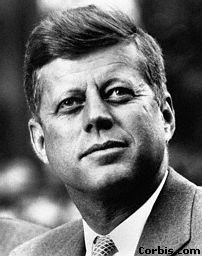
President Kennedy in 1960
It seemed John Fitzgerald Kennedy was destined to become President of the United States. He was born in Brookline, Massachusetts, on May 29, 1917, into a family that was heavily involved in politics. Both of his Grandfathers had been involved in Boston politics. Kennedy’s father, Joseph P. Kennedy, was a successful businessman who served as the Chairman of the Securities and Exchange Commission in Franklin D. Roosevelt’s administration.
The Kennedy’s were prominent Roman Catholics, but John didn’t attend Parochial school. Instead he attended a non-religious, but prestigious private school, and later went on to Harvard University. John graduated in 1940 having just average grades.
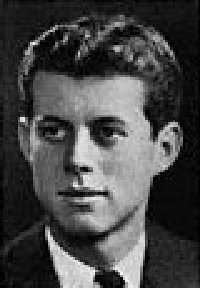
Kennedy’s graduation picture
After Kennedy finished school, he joined the navy just two months before the United States entered World War II. Kennedy became commander of a PT boat that was stationed in the South Pacific near the Solomon Islands. There a Japanese destroyer cut his ship in two leaving him in the water for 15 hours. During those 15 hours, Kennedy towed members of his crew to safety and then swam from island to island for the next several days searching for a rescue party. Kennedy later received the Navy and Marine Corps Medal for his display of heroism.
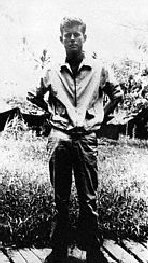
Lt. Kennedy in the Solomon Islands
After the war, John worked for the Hearst newspaper for a short while, then began to seek an elective office. His first run for office was for the Democratic Congressional seat in the 11th District of Massachusetts during the Election of 1946. He won with a 5 to 1 majority over his opponents. This started John F. Kennedy’s political career.
After that, he was re-elected to the United States House of Representatives twice. Kennedy was well-liked and independent voters loved him, along with many Republicans. Next, he ran for the Senate seat and won in 1952 over Republican Senator Henry Cabot Lodge.
During this time, Kennedy received a Pulitzer Prize for a book he wrote called "Profiles in Courage". The book was about the great political leaders in America, it was published in 1956. He wrote the book while being ill for a long time. Kennedy suffered since childhood from different illnesses: malaria, jaundice, adrenaline insufficiency, and a back injury.
In 1958, while facing a tough opponent named Estes Kefauver, Kennedy lost his seat in the Senate. Despite this loss, at age 41, Kennedy had already had an extremely successful political career and decided to take the next step.
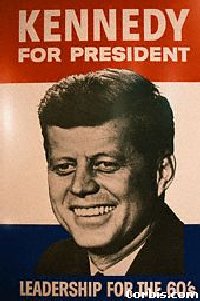
Kennedy’s campaigning poster
Kennedy started campaigning for the 1960 Presidential Election. Kennedy gave more than 150 speeches the first year of his campaign, 200 speeches the following year, and in 1960, he announced that he was running for President. He focused his campaign on unemployment and the slowness of the economy. His opponent was the Republican Vice President Richard Nixon, and it was a very close election, but Kennedy won. When he became President on January 20, 1961, he was the youngest man ever to be elected.
At the beginning of his Presidency, he faced a giant problem. A group of Cuban Refugees, supported by the CIA, made an attempt in April of 1961 to invade Communist Cuba. It was an absolute failure. Kennedy had to take the blame for the failure of "The Bay of Pigs Invasion."
But later Kennedy improved his image when he held a conference with the United Kingdom and the Soviet Union and made an agreement limiting nuclear bomb tests. This was one of the most important accomplishments of Kennedy’s first term. Kennedy went on doing a fairly good job as President until late 1963, when the United States and the World faced a shocking Nuclear confrontation. It was here the John F. Kennedy may very well have stopped World War III from starting.
The Soviets decided to take advantage of the young President and secretly built nuclear missile launching pads on the Island of Cuba pointed at the heartland of the United States. When Kennedy discovered the threat he reacted decisively and had the navy blockade Cuba. All ships carrying military supplies were turned back. Soviet nuclear submarines were dispatched and the world faced its first nuclear showdown. It got down to the last hour before the Solviets backed down. Kennedy promised the Solviets the United States would not invade Communist Cuba and the Solviets agreed to remove all the nuclear missiles from Cuba. This was known as the Cuban Missile Crisis.
In November of 1963, Kennedy traveled to Dallas, Texas, to help the Democratic governor raise funds for the upcoming election. It was planned that the President would make a speech at a fund raising dinner. On November 22 he was riding with his wife Jacqueline in a motorcade through Dallas, Texas, when Lee Harvey Oswald fired a fatal shot at Kennedy’s car. Kennedy was killed, and later the assassin was caught and arrested. Before Oswald could be questioned and tried, he was ambushed and shot by another assassin named Jack Ruby. Although events were very suspicious, Police found no evidence that Oswald was part of a larger conspiracy. Even though Oswald, who was 24 year old, had once worked for the CIA, and had earlier lived in the Soviet Union, nothing was ever found to link the assassination with any other country, group, or persons.
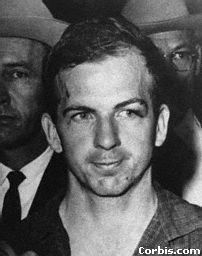
Lee Harvey Oswald
President John F. Kennedy is now buried in Arlington National Cemetery. The American people will never forget what President Kennedy accomplished for our country.
SOURCES:"Kennedy, John F." Encarta Interactive Encyclopedia (CD-ROM), 1999
"J.F.K. Biography" @ http://www.angelfire.com/me/mbkennedy/JFKBIO.html, 5/21/00
"Kennedy, John" Colliers Encyclopedia , Vol. 14. 1992 edition.
Picture #1 - "President Kennedy in 1960" From: http://search.corbis.com/
Picture #2 - "Kennedy’s graduation picture" From: http://search.corbis.com/
Picture #3 - "Lt. Kennedy in the Solomon Islands" From: http://search.corbis.com/
Picture #4 - "Kennedy’s campaigning poster" From: http://search.corbis.com/
Picture #5 - "Lee Harvey Oswald" From: http://search.corbis.com/